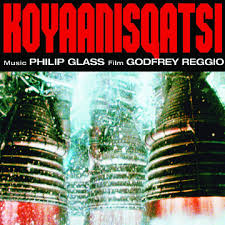“If we dig precious things from the land, we will invite disaster.”
If you undercrank stock footage of a city it looks frantic, and if you put peaceful music over a natural landscape it looks calm. That’s Koyaanisqatsi: an emotionally moving but intellectually casuistic tale of a supposed clash between modern man and nature.
Director Godfrey Reggio seeks to show the world we live in, but he relies heavily, too heavily, on audiovisual effect, and the film ends up feeling artificial and manipulated, a staged ballet pretending to be honest documentation.
I’m reminded of Luis Buñuel’s 1933 “documentary” of Spain’s remote Las Hurdes mountains, Land Without Bread. The film’s theme – Las Hurdes is a harsh land, where life is cheap – is sold by a powerful shot of a goat climbing a steep cliff and slipping and tumbling to its death. When you learn that the scene was staged (the goat was shot with a rifle) you feel a little cheated.
Godfrey Reggio’s film isn’t deceptive in the same way, but why contrast bustling cities with the Grand Canyon? Is this a logical or obvious comparison? Why not compare a city with a raging ocean? The Antarctic Circumpolar Current carries a million times as many tonnes of water through the Drake Passage as Times Square does cars. There is peacefulness in civilization, and instability in nature.
“Koyaanisqatsi” is a Hopi word, defined (according to Wikipedia) as “life of moral corruption and turmoil” or “life out of balance”. The film ends with Hopi prophecies portending our doom. The film’s reverence toward primitive man is of a piece with most environmentalist scare programming on TV: white people are bad, capitalism is bad, technology and industry are bad. Instead, we should take a moment to learn from beautiful primitive people, who have so much to teach us. It’s funny that most of the people promulgating this regressive message are politically left wing. Nostalgia for the 1950s makes you a conservative dinosaur, but nostalgia for 10000 BC makes you an enlightened child of the earth-spirit.
I don’t argue that modern society is perfect, but our greedy hyper-capitalist “life out of balance” has brought us good things, too: medicine, global communications, global transport, and the ability to make a film such as Koyaanisqatsi. We have created problems (such as climate change), but we can also create solutions. By contrast, the primitive people deified in the film are largely helpless against desertification, disease, ecological collapse, and so on. Any glamor the pre-technological life possesses probably lasts until your first toothache.
While I dislike Koyaanisqatsi‘s theme, I like almost everything else about it. It’s an extremely clever folding of sound over image (and vice versa), demonstrating how one can enhance and illuminate the other.
The visuals are powerful. Clouds slide in reflection across glass skyscrapers, time-lapsed so that they ripple and pulsate like gaseous alien creatures. Streams of traffic flow along streets, accelerated into rivers of pure light. Koyaanisqatsi was a microbudget production and contains a lot of stock footage, but the way this footage is cut together is clever and interesting.
Popular culture was influenced by Reggio’s style. The “sped-up urban footage” motif endemic to 90s music videos started here, for example. Near the end of the movie there’s an extended sequence where the camera tracks a person in the street…until they look up, notice they’re being filmed, and we cut to another person. To be honest, I’m not sure what the point is, but it’s a striking trick, and I’ve seen it imitated since.
Philip Glass’s music is the equivalent of a pointillistic painting, thousands of self-referential cycles of dying notes that seem to melt inside the ear like icicles. The soundtrack is complex yet paradoxically simple. Brian Eno’s pioneering ambient music in the 1970s attempted to reward any level of listener attention (whether you’re focusing intently or listening with half an ear, the music should be enjoyable), and Glass’s work achieves this with even more beauty and concision.
The film was released and the world kept turning. Reggio tried to reignite the fire of Koyaanisqatsi twice, with 1988’s Powaqqatsi (which was about third world exploitation), and Naqoyqatsi (which was about futurism and accelerationism).
The later films had bigger budgets but smaller impacts: they were like bombs landing on a target already blown to rubble. The trouble with making sequels to an experimental film is that, by definition, you’re no longer experimenting: you’re adding to a tradition. And even though Naqoyqatsi (in particular) tried to differentiate itself by amping up the digital editing to ridiculous and obnoxious levels, the Koyaanisqatsi approach had soaked into popular culture, and no longer seemed new or interesting. Hard to be impressed by time-lapse footage when you see the same stuff in Nike ads and Madonna music videos.
Koyaanisqatsi is an awkward beast. Its strongest element is its craft…the craft that subtly works against it at every turn, because it adds distance between the viewer and the reality on the screen. This is one of those films that might be better if it was less competently made, because then we might the truth, instead of a farrago of editing tricks.
No Comments »
Comments are moderated and may take up to 24 hours to appear.
No comments yet.

